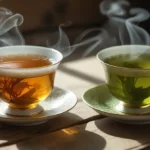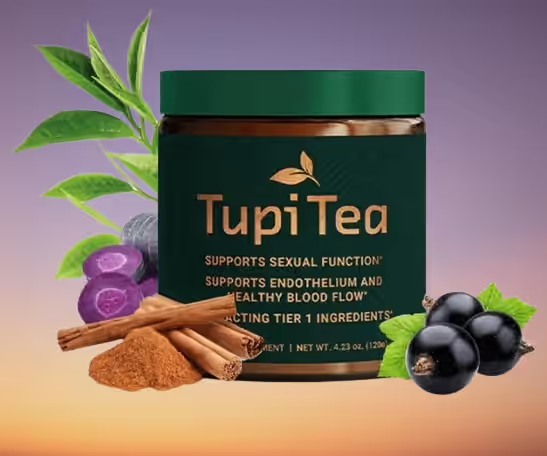Table of Contents
Darjeeling tea does it have caffeine? Yes, it certainly does – with each cup containing approximately 40-70 milligrams of caffeine.
When exploring the darjeeling tea caffeine content, we discovered something interesting. Research shows that Darjeeling contains about 1.7 grams of caffeine per 100 grams of leaf, generally more than other Indian loose leaf teas like Assam or Nilgiri. Still, compared to your morning coffee which typically packs around 95 milligrams per cup, Darjeeling offers roughly half the caffeine jolt. This explains why many tea enthusiasts find that Darjeeling provides a more balanced energy experience than coffee.
In this guide, we’ll explore everything you need to know about Darjeeling tea’s caffeine levels, how it compares to other beverages, what factors affect its potency, and the best ways to enjoy this renowned tea. Whether you’re looking to manage your caffeine intake or simply curious about this celebrated Indian tea, we’ve got you covered.
How much caffeine is in Darjeeling tea?
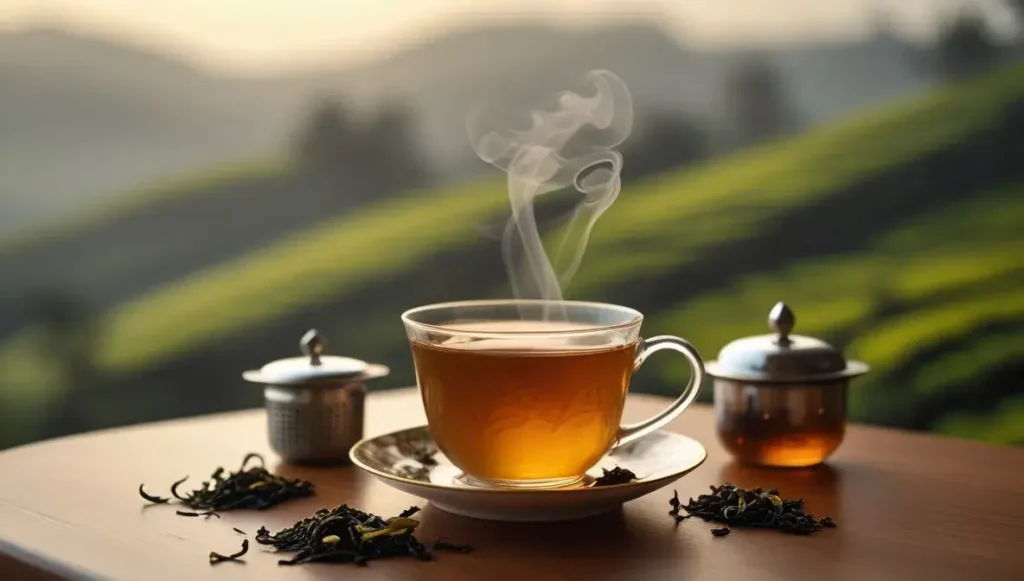
The caffeine content in Darjeeling tea varies depending on several factors, making it an interesting subject for tea enthusiasts who monitor their caffeine intake. Let’s explore the specifics of what’s actually in your cup.
Average caffeine range per cup
Darjeeling tea typically contains between 40-70 milligrams of caffeine per 8-ounce cup. This places it in the middle range of caffeinated beverages. However, some research indicates slightly different measurements – one study found that 3.5 ounces (100 grams) of Darjeeling tea leaves contains approximately 1.7 grams of caffeine. Since an average cup uses about 7 grams of tea leaves, this would translate to roughly 120 mg of caffeine per cup when fully extracted.
The variation in reported caffeine levels stems from differences in testing methods and brewing techniques. Furthermore, several factors influence the final caffeine content in your cup:
- Leaf grade and quality
- Brewing time (longer steeping extracts more caffeine)
- Water temperature (hotter water extracts caffeine more efficiently)
- Harvest season (spring harvests often contain more caffeine)
Additionally, different sources may report varying ranges because caffeine content naturally fluctuates based on growing conditions and processing methods.
Is Darjeeling tea decaffeinated?
Traditional Darjeeling tea always contains caffeine, but decaffeinated options are available for those seeking to reduce their caffeine intake. Reputable tea companies offer decaffeinated Darjeeling that maintains much of the original flavor profile.
The most common decaffeination method for quality Darjeeling tea uses supercritical carbon dioxide (CO₂). This natural process:
- Rinses the tea leaves with liquid carbon dioxide
- Selectively removes caffeine while preserving flavor compounds
- Avoids chemical solvents that might affect taste
- Leaves the tea with minimal caffeine content
Many decaffeinated Darjeeling teas use fine Second Flush (summer-harvested) leaves, which provide a robust flavor profile even after processing. The resulting tea typically maintains pleasant notes of flowers and honey with a copper-colored infusion.
A clever tip from tea connoisseurs: adding a small amount of high-quality regular tea to decaffeinated Darjeeling can enhance flavor while adding minimal caffeine.
Darjeeling black tea caffeine vs green and white
The processing method significantly impacts caffeine levels across different Darjeeling tea varieties. Here’s how they compare:
| Tea Type | Caffeine Content (per 8 oz cup) |
|---|---|
| Darjeeling Black | 40-70 mg |
| Darjeeling Green | 20-45 mg |
| Darjeeling White | 15–30 mg (typically) |
Darjeeling black tea undergoes complete oxidation during processing, which contributes to its higher caffeine content and more robust flavor profile. In contrast, Darjeeling green tea is produced by immediately halting oxidation through pan-frying or steaming, preserving more antioxidants but resulting in lower caffeine levels.
White Darjeeling, made from young leaves and buds with minimal processing, typically contains the least caffeine among the three varieties. This makes it an excellent option for those who enjoy Darjeeling’s distinctive character but prefer less caffeine, particularly in the evening.
Harvest timing also plays a role in caffeine content. First flush Darjeeling teas (spring harvest) often contain more caffeine than second flush (summer) or autumnal varieties. Therefore, if you’re sensitive to caffeine but still want to enjoy Darjeeling’s unique qualities, consider selecting later-season harvests.
👉 Grab the Premium Darjeeling Tea Everyone Is Talking About 👈
How Darjeeling compares to other teas and coffee
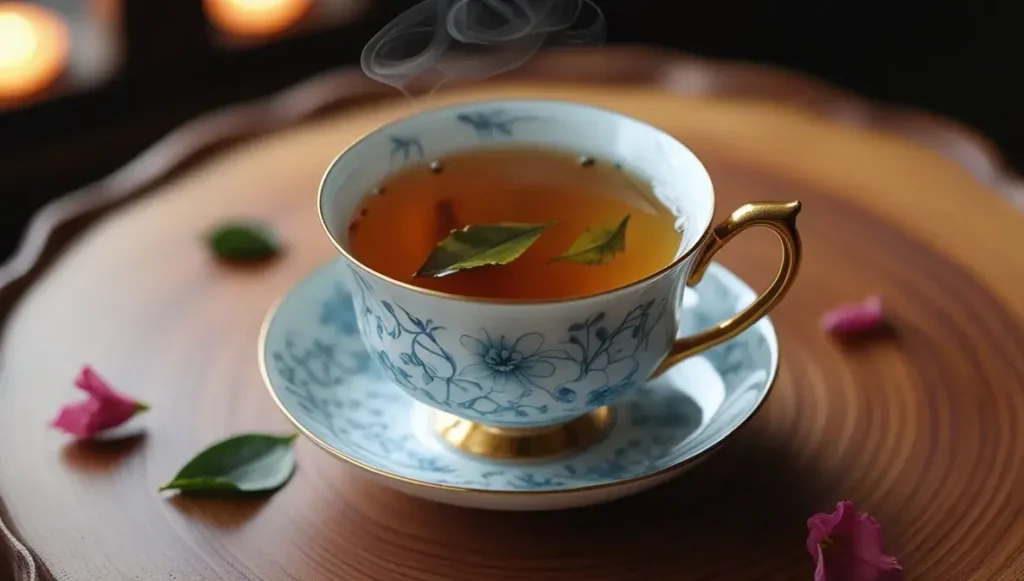
When comparing different caffeinated beverages, understanding where Darjeeling tea fits on the spectrum helps you make informed choices for your daily ritual. Let’s explore how this “Champagne of Teas” measures up against other popular drinks.
Darjeeling vs Assam and Earl Gray
Among black teas, Assam typically contains more caffeine than Darjeeling. This difference stems from their distinct varieties – Assam comes from the Camellia Assamica cultivar with larger leaves, naturally yielding higher caffeine content. Conversely, Darjeeling tea uses the Sinensis variety but still maintains relatively high caffeine levels by utilizing younger leaves.
Earl Gray offers an interesting comparison since it’s not a specific tea variety but rather a flavored blend. Traditionally made with robust black tea (often Assam) and scented with bergamot oil, Earl Gray typically contains about 40-70 mg of caffeine per cup. This places it in roughly the same caffeine range as Darjeeling.
Flavor-wise, these teas differ substantially:
- Darjeeling: Often described as having a muscatel-like flavor with notes of flowers, fruits, and spices
- Assam: Known for its strong, malty, and robust character
- Earl Gray: Distinguished by its citrusy bergamot aroma overlaying the base black tea
Notably, despite similar caffeine content, many tea drinkers report Darjeeling feels gentler on the system compared to Assam’s more potent energy kick.
Darjeeling vs green tea and herbal teas
Darjeeling black tea contains considerably more caffeine than both green and white tea varieties. Here’s how they compare:
| Tea Type | Caffeine Content (per cup) |
|---|---|
| Darjeeling Tea | 40-70 mg |
| Green Tea | 20-45 mg |
| White Tea | 15-30 mg |
| Herbal Tea | 0 mg (naturally caffeine-free) |
| Kombucha | 6-15 mg |
| Oolong Tea | 30-60 mg |
| Matcha Tea | 70 mg |
Even Darjeeling green tea contains less caffeine than its black counterpart—approximately 20-45 mg per cup. This makes green Darjeeling an excellent middle-ground option for those seeking moderation in their caffeine intake.
Throughout the day, you might consider switching between varieties. For morning alertness, Darjeeling black tea provides sufficient energy without coffee’s intensity. For afternoon sipping, Darjeeling green tea offers milder stimulation. Herbal teas remain the only completely caffeine-free option among tea varieties.
Darjeeling tea vs coffee caffeine levels
The difference between Darjeeling tea and coffee caffeine levels is substantial. An average cup of coffee contains 95-200 mg of caffeine, approximately double the amount found in Darjeeling tea (40-70 mg). For those sensitive to caffeine yet still wanting some energy boost, this makes Darjeeling an ideal alternative.
Beyond mere numbers, the way your body processes caffeine from tea differs from coffee:
- Tea caffeine typically releases more gradually into your system
- The L-theanine in tea (including Darjeeling) works synergistically with caffeine to provide a more balanced alertness
- Many people experience fewer “jitters” with tea compared to coffee
Furthermore, Darjeeling tea offers versatility across its harvest seasons. First Flush (spring harvest) Darjeeling tends to be lighter with a delicate flavor, whereas Second Flush (summer harvest) provides a fuller, more robust character. This seasonal variation gives you options for different caffeine experiences throughout the year.
In essence, for those asking “does Darjeeling tea have caffeine compared to coffee?” – yes, it absolutely does, albeit at roughly half the strength, making it an excellent middle-ground option for the caffeine-conscious consumer.
What affects the caffeine content in Darjeeling tea
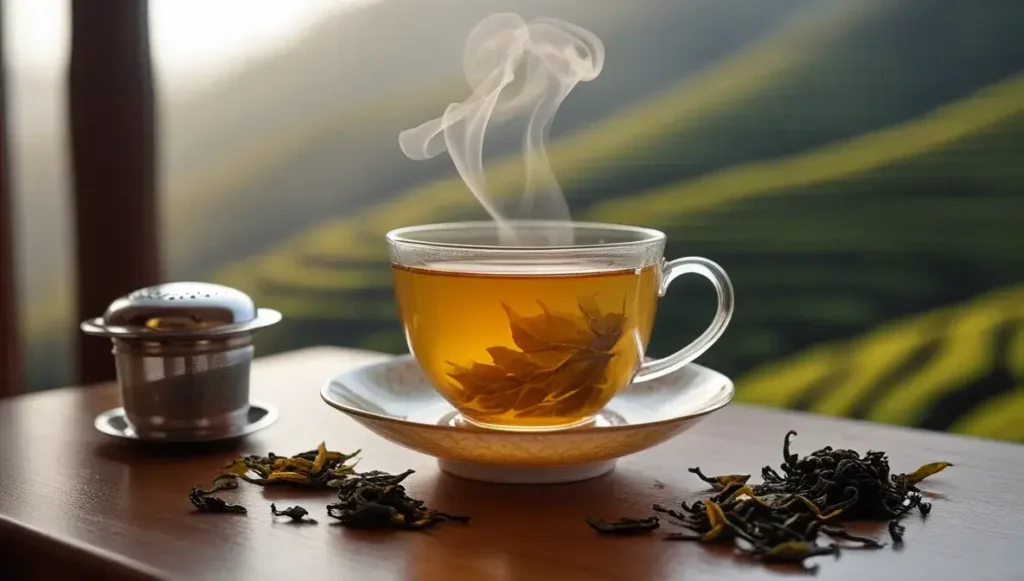
The fascinating world of Darjeeling tea extends beyond its exquisite taste – the caffeine content fluctuates based on several key factors. Understanding these variables helps you customize your tea experience according to your caffeine preferences.
Flush type and harvest season
The time of year when Darjeeling tea is harvested plays a crucial role in determining its caffeine levels. First flush teas, harvested in early spring, often contain higher caffeine content than later harvests. This happens because young leaves and buds naturally pack more caffeine as a defense mechanism against insects.
Although it’s commonly believed that second flush (summer) Darjeeling has less caffeine, some research suggests the opposite – that second flush teas may actually contain more caffeine than first flush varieties. Meanwhile, autumnal flush teas typically offer lower caffeine levels, making them suitable for evening consumption.
The seasonal effect on caffeine extends beyond just timing:
- Spring harvests (First Flush): Delicate flavor with potentially higher caffeine
- Summer harvests (Second Flush): More robust, muscatel flavor with varying caffeine levels
- Autumn harvests: Mellow, well-rounded taste with typically lower caffeine content
Leaf grade and processing method
The processing method substantially influences caffeine content in your cup. As Darjeeling tea moves through production stages, caffeine concentration increases – from fresh leaves (178.5 μg/g) to final processed tea (449.5 μg/g).
Moreover, leaf grade makes a noticeable difference. Younger tea leaves and buds contain more caffeine than mature leaves. This explains why high-grade Darjeeling with more buds and tips often delivers a stronger caffeine kick. Similarly, broken leaves release caffeine more rapidly than whole leaves due to increased surface area.
The oxidation level is equally important. Fully oxidized Darjeeling black tea contains approximately 40-70 mg of caffeine per cup, whereas Darjeeling green tea (which undergoes minimal oxidation) contains just 20-45 mg.
Brewing time and water temperature
Your brewing technique significantly affects how much caffeine ends up in your cup. Longer steeping times extract more caffeine – a critical consideration for caffeine-sensitive individuals.
Water temperature is equally consequential. For optimal flavor without excessive caffeine extraction, experts recommend brewing Darjeeling at 85-95°C (185-203°F). Boiling water (100°C/212°F) extracts caffeine more efficiently but might compromise flavor subtleties.
A study demonstrated this relationship dramatically – brewing 5 grams of tea leaves in 100ml of water at 20°C yields just 2.2 mg of caffeine, while the same amount brewed at 100°C produces 67 mg.
The leaf-to-water ratio further impacts caffeine extraction – more tea leaves relative to water results in higher caffeine concentration. For a perfectly balanced cup, consider adjusting these variables according to your caffeine tolerance and flavor preferences.
👉 Taste the Best Darjeeling Tea for an Unforgettable Experience 👈
Health benefits of Darjeeling tea
Beyond its distinctive flavor and caffeine content, Darjeeling tea offers numerous health benefits that make it a valuable addition to your daily routine.
Antioxidants and immune support
Darjeeling tea contains powerful antioxidants including thearubigins, theaflavins, and catechins that actively combat free radicals in your body. These compounds effectively neutralize harmful chemicals during digestion and eliminate toxins. Research shows that Darjeeling tea leaves contain significant levels of polyphenols, ranging between 28-241 mg per gram of dry leaf weight.
The antioxidant properties help strengthen your immune system, enabling your body to fight infections and illnesses more effectively. Specifically, certain polyphenols in Darjeeling tea form receptors that bind free radicals and initiate immune responses. L-theanine, another compound found in Darjeeling tea, further enhances immunity.
Weight management and metabolism
For those monitoring their weight, Darjeeling tea can be particularly beneficial. Studies indicate that regularly drinking Darjeeling tea helps reduce belly fat and accelerates weight loss. This effect likely stems from its high concentration of catechins, which increase fat burning and boost metabolism.
Semi-oxidized Darjeeling varieties appear especially effective for weight management compared to other teas. Moreover, as a low-calorie beverage, unsweetened Darjeeling tea can support weight loss when substituted for higher-calorie drinks.
Heart and bone health
Darjeeling tea offers substantial cardiovascular benefits. Regular consumption helps lower cholesterol levels thanks to the flavonoids and phytonutrients it contains. In fact, drinking tea regularly has been associated with a 20% reduction in heart disease and stroke risk, and a 22% decrease in fatal cardiovascular events.
Regarding bone health, research suggests that Darjeeling tea increases bone density. Studies have found that women who regularly consume tea have approximately 3% greater bone density than non-tea drinkers. The polyphenols in Darjeeling tea appear to slow the pace of bone density loss, potentially reducing osteoporosis risk.
Is Darjeeling tea good for you?
Considering its comprehensive health profile, Darjeeling tea undoubtedly offers significant benefits:
- It possesses antimicrobial properties that may improve oral health and treat gastrointestinal bacterial infections
- The aroma alone can have calming effects, improving mood during stressful situations
- It contains tannins that may be neuroprotective, supporting brain health
- It stimulates good bacteria growth in your digestive system
- Compounds in Darjeeling tea may help prevent cavities and strengthen tooth enamel
Indeed, experts suggest that even small benefits from drinking tea could have significant impacts on global public health.
How to brew and enjoy Darjeeling tea
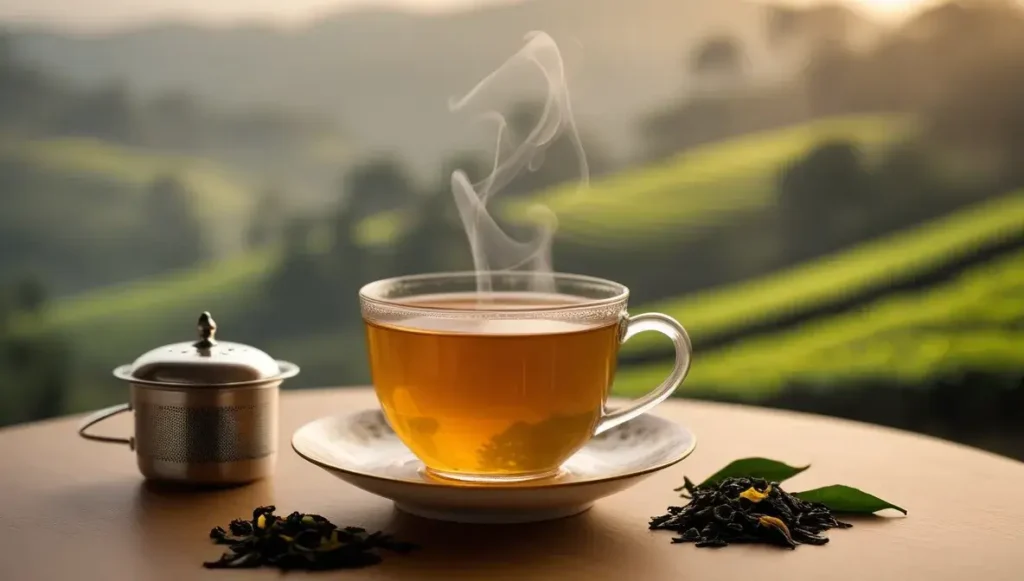
Brewing the perfect cup of Darjeeling tea is both an art and science that enhances its complex flavors while managing caffeine extraction.
Ideal water temperature and steeping time
For first flush Darjeeling, water temperature should be around 80-85°C (175-185°F), which preserves delicate flavors and prevents bitterness. Second flush varieties can handle slightly hotter water at 85-95°C (185-203°F). Primarily, the water should be freshly boiled then allowed to cool slightly—never use boiling water directly on the leaves.
Steeping time varies based on preference, nonetheless 3-4 minutes is ideal for most Darjeeling teas. First flush varieties benefit from shorter steeping (3 minutes), while second flush can steep longer (3-5 minutes). For a second infusion of premium leaves, increase steeping time to 5 minutes.
Best time of day to drink Darjeeling tea
Morning or early afternoon is ideal for enjoying Darjeeling tea. Initially, avoid drinking immediately after waking up on an empty stomach if you have sensitivity issues. For optimal digestion, consume Darjeeling at least 2 hours after meals.
Evening consumption is possible given Darjeeling’s moderate caffeine content, consequently drink your last cup at least 2 hours before bedtime. As well as being refreshing, Darjeeling works well as an afternoon pick-me-up between work sessions.
Tips for maximizing flavor and benefits
Use filtered water to prevent impurities from affecting flavor. For this purpose, a 1:1 ratio of one teaspoon (approximately 2-2.5g) of tea leaves per 8-ounce cup works best. Preheat your teapot or cup with hot water before adding leaves.
Darjeeling tea is typically best enjoyed without milk or sugar to experience its natural muscatel and fruity notes. Porcelain or glass teapots are excellent brewing vessels as they don’t affect flavor.
Common mistakes to avoid
At this point, be aware of common brewing pitfalls. Avoid using soap to clean teapots as residue can interfere with flavor. Don’t use metallic infusion balls which restrict leaf expansion and distort taste. Skip previously boiled water which alters tea flavor.
Oversteeping beyond 5 minutes leads to bitterness. Store tea leaves in airtight containers in cool, dry places to preserve freshness. Essentially, rushing the brewing process by not allowing proper steeping time robs you of Darjeeling’s full flavor profile.
👉 Discover Top-Quality Darjeeling Tea for Your Perfect Afternoon 👈
Darjeeling Tea Does It Have Caffeine? Final Thoughts
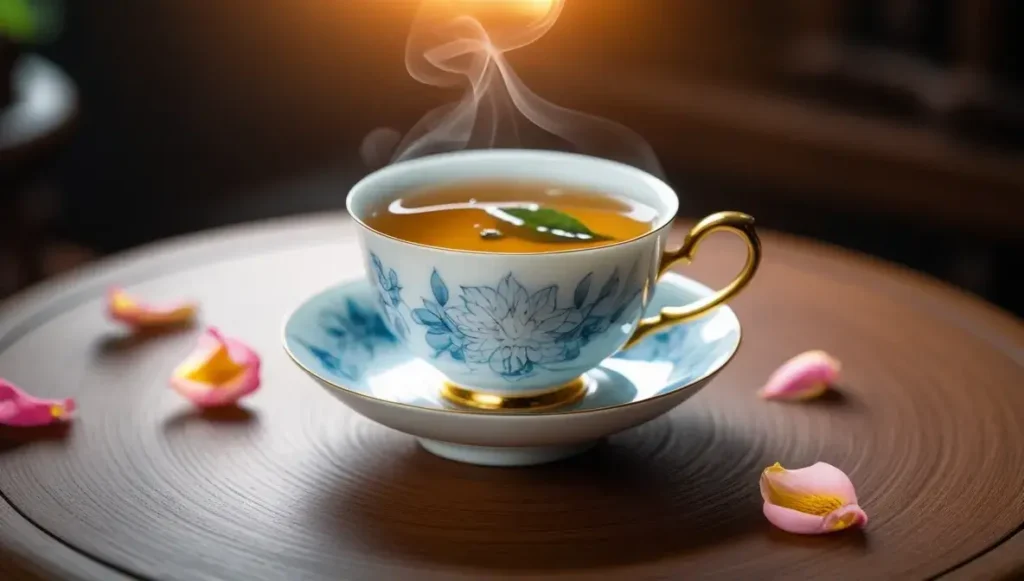
Darjeeling tea stands as a remarkable beverage that balances delightful flavor with moderate caffeine content. Throughout this exploration, we’ve discovered that a typical cup contains between 40-70 milligrams of caffeine – enough to provide gentle alertness without the jitters often associated with coffee.
The caffeine experience from Darjeeling differs significantly from other beverages. First flush varieties offer more caffeine than later harvests, while the processing method and brewing techniques also play crucial roles in determining the final caffeine concentration in your cup. Additionally, the L-theanine present works synergistically with caffeine to create a more balanced energy boost compared to coffee’s intense jolt.
Beyond its caffeine profile, Darjeeling tea offers impressive health advantages. The rich antioxidant content supports immune function, while regular consumption may benefit heart health, bone density, and weight management. These benefits make Darjeeling an excellent choice for health-conscious tea drinkers.
Brewing techniques matter tremendously when preparing the perfect cup. Water temperature, steeping time, and tea quality all affect both flavor and caffeine extraction. Therefore, paying attention to these details will reward you with a truly exceptional tea experience.
Whether you choose first flush for its delicate notes or second flush for robust muscatel flavors, Darjeeling tea provides a wonderful alternative to higher-caffeine beverages. After all, the “Champagne of Teas” delivers not just an exquisite taste but also a balanced energy that supports your daily routine without overwhelming your system.
Next time you reach for your teacup, remember that Darjeeling offers both pleasure and wellness benefits that few other beverages can match. This perfect harmony of taste, tradition, and health makes Darjeeling tea a truly special addition to any tea collection.
Key Takeaways
Understanding Darjeeling tea’s caffeine content helps you make informed choices for your daily tea ritual while enjoying its unique health benefits and exquisite flavor profile.
• Darjeeling tea contains 40-70mg of caffeine per cup – roughly half of coffee’s content, providing gentle energy without jitters
• First flush (spring) Darjeeling typically has higher caffeine than second flush (summer), while processing method significantly affects final levels
• Brewing technique matters: water temperature of 80-95°C and 3-4 minute steeping time optimize both flavor and caffeine extraction
• Rich in antioxidants and polyphenols, Darjeeling supports immune function, heart health, and weight management beyond just caffeine benefits
• Morning to early afternoon is ideal timing for consumption, allowing you to enjoy the energy boost without disrupting sleep patterns
The “Champagne of Teas” offers a perfect balance of moderate caffeine, exceptional taste, and wellness benefits that make it an excellent alternative to higher-caffeine beverages for health-conscious tea enthusiasts.
👉 Enjoy Top-Rated Darjeeling Tea Straight from the Himalayas 👈
FAQs
Q1. How much caffeine is in a cup of Darjeeling tea? A typical cup of Darjeeling tea contains between 40-70 milligrams of caffeine. This is about half the amount found in a cup of coffee, making it a good option for those seeking a gentler energy boost.
Q2. Is Darjeeling tea suitable for evening consumption? While Darjeeling tea does contain caffeine, its moderate levels make it possible to enjoy in the evening. However, it’s best to have your last cup at least 2 hours before bedtime to avoid potential sleep disruptions.
Q3. How does Darjeeling tea compare to other teas in terms of caffeine content? Darjeeling tea generally has more caffeine than green or white teas, but less than Assam black tea. Its caffeine content is similar to Earl Gray, typically ranging from 40-70 mg per cup.
Q4. What are the main health benefits of drinking Darjeeling tea? Darjeeling tea is rich in antioxidants, which support immune function. Regular consumption may also benefit heart health, aid in weight management, and contribute to stronger bones. It’s also known for its potential to improve mood and oral health.
Q5. How should I brew Darjeeling tea for the best flavor and optimal caffeine extraction? For the best results, use water between 80-95°C (175-203°F) depending on the flush. Steep for 3-4 minutes, using about one teaspoon of leaves per 8-ounce cup. Avoid using boiling water directly on the leaves to prevent bitterness and over-extraction of caffeine.
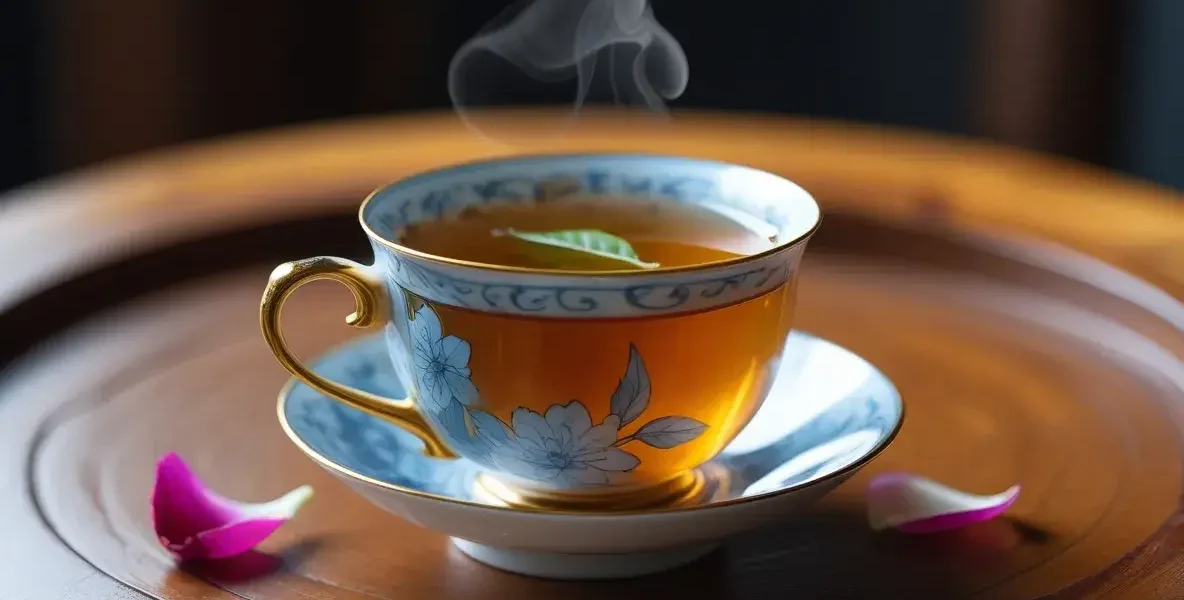
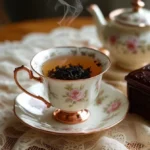

![Jasmine Tea vs Green Tea Benefits: Which Gives Better Health Results? [2025] jasmine tea vs green tea benefits](https://www.goteaworld.com/wp-content/uploads/2025/09/jasmine-tea-vs-green-tea-benefits-150x150.webp)
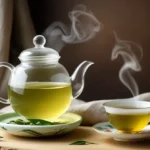


![Pu Erh Tea vs Green Tea: Which is Better for Daily Health? [2025] pu erh tea vs green tea](https://www.goteaworld.com/wp-content/uploads/2025/10/pu-erh-tea-vs-green-tea-150x150.webp)
